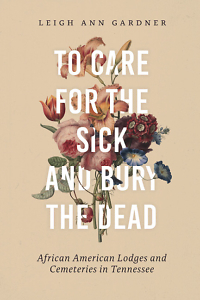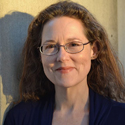In the tumultuous decades after the Civil War, African American communities all over the country established fraternal and benevolent organizations. Some, such as the Prince Hall Masons, paralleled white organizations from which people of color were generally excluded. Others, like the United Sons of Ham, originated within the African American community.
 These organizations, or “lodges,” provided aid of many kinds during an era when there was no government safety net. In the segregated South, including Tennessee, one of their most important functions was the creation and maintenance of cemeteries. Lodge activity declined in the 20th century, and in many cases these cemeteries are all that remain. Leigh Ann Gardner’s To Care for the Sick and Bury the Dead delves into the history of Tennessee’s African American lodges and offers an illustrated survey of extant cemeteries across the state, along with an explanation of their distinctive burial practices.
These organizations, or “lodges,” provided aid of many kinds during an era when there was no government safety net. In the segregated South, including Tennessee, one of their most important functions was the creation and maintenance of cemeteries. Lodge activity declined in the 20th century, and in many cases these cemeteries are all that remain. Leigh Ann Gardner’s To Care for the Sick and Bury the Dead delves into the history of Tennessee’s African American lodges and offers an illustrated survey of extant cemeteries across the state, along with an explanation of their distinctive burial practices.
Gardner, a Nashville native who lives in Rutherford County, holds a master’s degree in public history and works in historic preservation. She answered questions from Chapter 16 by email.
Chapter 16: Can you tell us a little about the genesis of this project? Was it the cemeteries themselves or the history of the lodges that first drew you in?
Leigh Ann Gardner: I started researching a single lodge (the Working People’s Labor and Art Association) in Rutherford County in 2010 while in graduate school. I was intrigued by the name and wanted to know the group’s purpose. From there, I learned of other African American lodges in Rutherford County and that we had a lodge cemetery, Benevolent Society No 11 Cemetery, located one mile from Murfreesboro’s downtown square. Within a few months, I had found several other Benevolent Society cemeteries in Montgomery and Davidson Counties. I then decided to try to document all the African American lodges in Tennessee, little dreaming that I would still be documenting and researching a decade later.
I found myself more drawn to cemeteries in the last few years as some of them are the only remaining physical remnants of their lodges.
Chapter 16: Can you give us a thumbnail explanation of the role the lodges played in the African American community? Beyond creating cemeteries, what services did they provide?
Gardner: Lodges were vitally important in the African American community. I think of them as the third pillar of the community, along with churches and schools. Lodges provided a place for people to gather, to exercise leadership, to care for each other, and a place for recreation and entertainment. In some communities, lodges shared building space with schools and/or churches too. Also, in a time of increasing segregation, lodge buildings were sometimes one of the few places that African Americans could gather in their communities. Lodges are interesting in that they drew people from all economic classes, all educational backgrounds, and all religious denominations to come together for a common purpose.
Chapter 16: I’m sure some readers will be interested in using your book as a guide to visiting African American lodge cemeteries across the state. Are there sites you’d particularly recommend visiting?
 Gardner: I think the Odd Fellows Cemetery complex in Knoxville is a wonderful place to visit. The community and local groups have taken a cemetery that was in poor condition and created a place with walking paths and places to sit. To me, it has become a place of contemplation in addition to being a burial place. I also really enjoy Mount Ararat in Nashville as it has several distinct sections, and there are so many interesting gravestones to study. If you prefer less populated places, Agnew Benevolent Cemetery in Giles County and Laguardo Benevolent Cemetery in Wilson County are great examples of more rural cemeteries in excellent condition.
Gardner: I think the Odd Fellows Cemetery complex in Knoxville is a wonderful place to visit. The community and local groups have taken a cemetery that was in poor condition and created a place with walking paths and places to sit. To me, it has become a place of contemplation in addition to being a burial place. I also really enjoy Mount Ararat in Nashville as it has several distinct sections, and there are so many interesting gravestones to study. If you prefer less populated places, Agnew Benevolent Cemetery in Giles County and Laguardo Benevolent Cemetery in Wilson County are great examples of more rural cemeteries in excellent condition.
Chapter 16: You point out that the obscurity of some of the cemeteries outside the local community might actually be protective. A little-known burial ground is less likely to be vandalized. Yet obscurity can also put a cemetery at risk to encroaching development. What would you say to someone who is uncomfortable with making a site more publicly known?
Gardner: It is a question that I struggle with personally. When I visit a cemetery, I complete a field assessment form to collect certain information, which includes GPS coordinates and directions. I purposefully did not include this type of information as I don’t wish to endanger any of these sites. I do feel that local authorities, such as property assessor’s offices, should know where all the cemeteries in their counties are located so that developers are aware of burial sites before they begin work. I know that in Rutherford County, where I live, the Rutherford County Archives and the Rutherford County GIS department partnered several years ago to document all burial sites in the county. I wish more counties would do something similar.
Chapter 16: You mention Tennessee cemeteries, such as the Eastport Cemetery in Knoxville and the Union Forever Cemetery in Memphis, which are currently untended and thus more at risk of destruction. What can be done proactively to preserve these sites?
Gardner: We can’t preserve that which we don’t know exists, so I think the first thing that can be done is for communities to document the presence of all burial sites. I think this would require grassroots efforts between different groups working together to document burial sites. I know there was a bill in 2019/2020 that passed the U.S. Senate to create an African American Burial Grounds Network. However, I don’t believe the bill ever passed the House. The bill called for developing a program to train states and local governments on identifying African American burial grounds. Something like that would have been such a nice resource to assist communities in identifying cemeteries at risk for destruction.

Maria Browning is a fifth-generation Tennessean who grew up in Erin and Nashville. Her work has appeared in Guernica, The Los Angeles Review of Books, and The New York Times. She’s the editor of Chapter 16.
Tagged: 2022 Southern Festival of Books, Q&A





